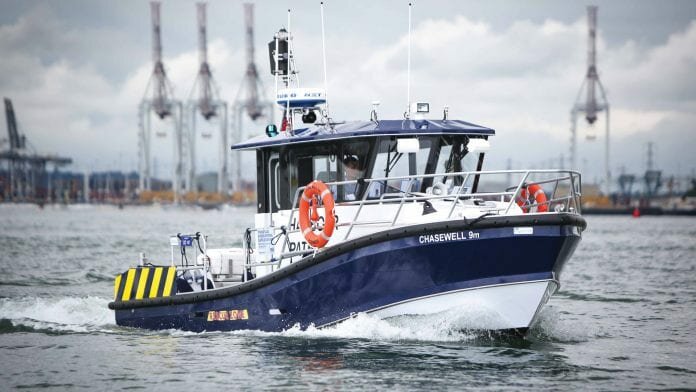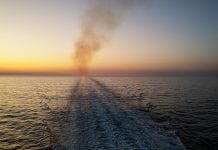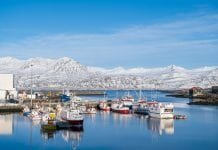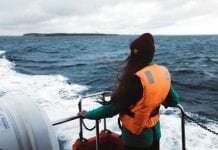
UK shipbuilder Wight Shipyard Co’s new hybrid vessel can help operators including port and river authorities, the police, Ministry of Defence (MOD) and Royal Navy to meet strict new pollution standards.
It is now commonly accepted that we are in an age of climate crisis, with air pollution at record levels in many cities across the world. The European Court of Justice (ECJ) has recently backed stricter air standards and cities across Europe and the UK is introducing regulation to ensure air quality is not worsened by emissions.
Aside from high levels of personal transport use, many industries contribute to poor air quality; from shipping to long haul flights to manufacturing and the Ministry of Defence. Finding a solution to high industry pollution will help us get one step closer to cleaner air for all.
One company offering a solution is Wight Shipyard Co: Europe’s leading highspeed craft and aluminium ship builder, located on the Isle of Wight.
Wight Shipyard Co (WSC) started life in 2010 as Shemara Refit LLP, born out of a unique project to manage the revival of a magnificent motor yacht to her former glory. Since then the business has grown exponentially: 2019 has seen the delivery of three fast ferries for international export to Mexico and Austria; with the second of two ferries delivered for work on the Thames with MBNA Thames Clippers and a further four in build, again for export.
WSC has been redefining ship building, focused on lightweight ships and fuel efficiency. With first class managerial, design and technical expertise, WSC has recorded exceptional success in the fast ferry sector, delivering high-performance, cutting edge designs and the most comfortable passenger accommodation in fuel efficient hull forms.
With an established reputation for providing vessels built to the highest possible standards, the WSC team has a wealth of knowledge stemming from years of experience working on defence, commercial and luxury yacht projects.
Stricter environmental regulation
The port environment is becoming an ever stricter environment to work in when it comes to environmental regulation and clean air requirements. Restrictions on fuel emissions have tightened and port authorities, harbour and river patrols now require vessels to operate at variable speeds to minimise their environmental impact.
The UK government has launched Maritime 2050, a strategy setting out its vision and ambitions for the future of the British maritime sector and anticipating potential challenges and opportunities. One of the strategy’s seven focus areas is the environment. The aim is to bring the UK shipping industry in line with the Paris Climate Agreement; and a strategy is in development to reduce greenhouse gases in the industry using low- and zero-emission technologies.
The government’s call for evidence on Maritime 2050 notes: ‘Environmental concerns, particularly around emissions, are expected to drive significant change in the design, operation and management of ships…The ocean is a fragile and vulnerable ecosystem as well as an important resource for, among other things, transport, energy and leisure. With the numerous acute pressures placed upon it, it is important to continue to press hard towards making maritime activity sustainable. Our coastlines and coastal communities are also vulnerable to environmental impacts from shipping, such as litter and noise, and emissions from ships have the potential to harm human health and the environment inland. The UK wants to take a holistic approach to effectively tackling environmental challenges within the maritime world at both international and domestic levels.’
A shipping solution
WSC’s new hybrid vessel offers operators one viable solution to this problem. The 9m Hybrid Patrol Vessel allows operators the option to operate at different speeds; meaning when environmental considerations are required or regulations are in force in an area, they can operate at slower speeds, with the possibility to operate at faster speeds when required or in emergency situations. This amounts to a reduction in fuel cost as well as a reduction in emissions. There is an added benefit of reduced maintenance because there is the ability to turn off the main engines for substantial periods of time.
Peter Morton, CEO of WSC, said: “This groundbreaking project aims to set new standards in high speed, fuel economy and lightweight vessels in the sector. Building greener vessels has been an integral focus for some time now so moving into hybrid options is the obvious next step forward.”
The WSC vessel has been designed by naval architect firm Chartwell Marine and built in collaboration with Andy Page, naval architect and Managing Director of Chartwell Marine. Page noted that the vessel has a unique hybrid system architecture and an innovative new hull form that minimises drag and resistance throughout the speed range, adding that the hull form results from extensive research undertaken by the team at Chartwell Marine into low speed resistance, enabling efficient performance under both diesel and electrical propulsion.
Page said: “Ultimately this hull form, optimised through extensive computational flow dynamics (CFD) testing, allows the operator to maximise time spent on electrical power, with substantial advantages when it comes to reducing total emissions. WSC brings superior build quality and workmanship and a specific focus on weight reduction and fuel efficiency. This has a natural lead in to the growing hybrid requirement.”
Power
Marine and Industrial Transmissions Limited (MIT) and its manufacturing and technology partner Transfluid, are providing the hybrid system for the vessel. The Transfluid HM560 marine hybrid unit used in the drive configuration delivers ratings of up to 164kW diesel power and 20kW electric power. Using rechargeable batteries and an integral battery management system, the unit actively manages power output and charge rate depending on the battery status and condition. Meanwhile, the control system allows users to easily switch between operating modes. The intelligent software can also integrate with other onboard systems for extended control and diagnostics; all combining to create a hybrid vessel for the maritime industry that is much more fuel efficient.
Peter Morton
CEO
Wight Shipyard Co
+44 (0)1983 296560
Twitter @WightShipyard
www.wightshipyard.com


















